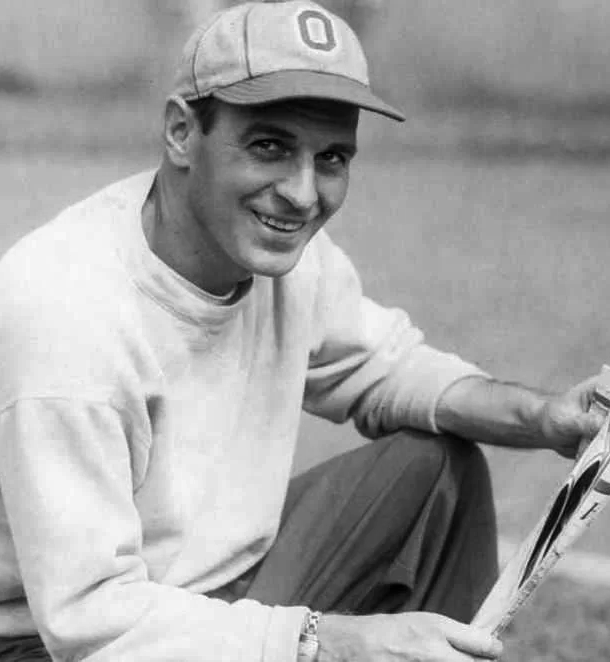Paul Eugene Brown was an American football coach in the All-America Football Conference and National Football League. Brown was the first coach of the Cleveland Browns, a team named after him, and later played a role in founding the Cincinnati Bengals. His teams won seven league championships in a professional coaching career spanning 25 seasons.
Brown began his coaching career at Severn School in 1931 before becoming the head football coach at Massillon Washington High School in Massillon, Ohio, where he grew up. His high school teams lost only 10 games in 11 seasons. He was then hired at Ohio State University and coached the school to its first national football championship in 1942. After World War II, he became head coach of the Browns, who won four AAFC championships before joining the NFL in 1950. Brown coached the Browns to three NFL championships – in 1950, 1954 and 1955 – but was fired in January 1963 amid a power struggle with team owner Art Modell. Brown in 1968 co-founded and was the first coach of the Bengals. He retired from coaching in 1975 but remained the Bengals’ team president until his death in 1991. The Bengals named their home stadium Paul Brown Stadium in honor of Brown. He was inducted into the Pro Football Hall of Fame in 1967.
Brown is credited with a number of American football innovations. He was the first coach to use game film to scout opponents, hire a full-time staff of assistants, and test players on their knowledge of a playbook. He invented the modern face mask, the taxi squad and the draw play. He also played a role in breaking professional football’s color barrier, bringing some of the first African-Americans to play pro football in the modern era onto his teams. Despite these accomplishments, however, Brown was not universally liked. He was strict and controlling, which often brought him into conflict with players who wanted a greater say in play-calling. These disputes, combined with Brown’s failure to consult Modell on major personnel decisions, led to his firing as the Browns’ coach in 1963.
Early life
Brown grew up in Massillon, Ohio, where he moved with his family from Norwalk, Ohio when he was nine.[5] His father, Lester, was a dispatcher for the Wheeling and Lake Erie Railroad. Massillon was a shipping and steel town obsessed with its high school and professional football teams, both called the Tigers. Massillon’s main rival at both levels was nearby Canton, Ohio, at the time a bigger and richer town. When the professional teams folded in the 1920s, the rivalry between the high school teams took center stage.
Brown entered Massillon Washington High School in 1922. Although he played football as a child, Brown was undersized for the game at less than 150 pounds and at first focused his athletic energies on the pole vault. Harry Stuhldreher, who went on to be one of Notre Dame’s legendary Four Horsemen, was then the high school quarterback. But Massillon coach Dave Stewart saw Brown’s determination to be a good vaulter despite his small size and brought him onto the football team; as a junior in 1924, he took over as the starting quarterback. Massillon posted a win-loss record of 15–3 in Brown’s junior and senior years as the starter.
Brown graduated in 1925 and enrolled at Ohio State University the following year, hoping to make the Buckeyes team. He never got past the tryout phase. After his freshman year, he transferred to Miami University in Oxford, Ohio, where he followed Weeb Ewbank as the school’s starting quarterback. Under Coach Chester Pittser, Brown was named to the All-Ohio small-college second team by the Associated Press at the end of 1928. In two seasons at Miami, Brown guided the team to a 14–3 record. He married his high school sweetheart Katie Kester the following year. Brown had taken pre-law at Miami and considered studying history on a Rhodes Scholarship, but after college he instead took his first job as a coach. On Stewart’s recommendation, Severn School, a private prep school in Maryland, hired him in 1930.
Cleveland Browns in the AAFC (1946–1949)
By the time Brown arrived in Cleveland, the team had signed a number of players to its roster, including quarterback Otto Graham, whose Northwestern squad had beaten the Buckeyes in 1941. Many of the players came from Ohio State, Great Lakes and Massillon teams that Brown coached. Lou Groza, a placekicker and tackle, played for Brown at Ohio State before the war intervened. Receiver Dante Lavelli was a sophomore on Ohio State’s championship-winning team in 1942. Bill Willis, a defensive lineman who Brown coached at Ohio State, and Marion Motley, a running back who grew up in Canton and played for Brown at Great Lakes, became two of the first black athletes to play professional football when they joined the team in 1946. Other signings included receiver Mac Speedie, center Frank Gatski and back Edgar “Special Delivery” Jones. Brown brought in assistants including Blanton Collier, who had been stationed at Great Lakes and met Brown at Bluejackets practices.
The name of the team was at first left up to Brown, who rejected calls for it to be christened the Browns. McBride then held a contest to name the team in May 1945; “Cleveland Panthers” was the most popular choice, but Brown rejected it because it was the name of an earlier failed football team. “That old Panthers team failed,” Brown said. “I want no part of that name.” In August, McBride gave in to popular demand and christened the team the Browns, despite Paul Brown’s objections. With the roster fixed and the team’s name chosen, Brown set out to build a dynasty. “I want to be what the New York Yankees are in baseball or Ben Hogan is in golf,” he said.
After a training camp at Bowling Green State University, the Browns played their first game in September 1946 at Cleveland Stadium. A crowd of 60,135 people showed up to see the Browns beat the Miami Seahawks 44–0, then a record attendance mark for professional football. That touched off a string of wins; the team ended the season with a 12–2 record and the top spot in the AAFC’s western division. The Browns then beat the AAFC’s New York Yankees in the championship.
Cleveland won the AAFC championship again in 1947 behind an offensive attack that employed the forward pass more frequently and effectively than was typical at the time. The Browns’ offensive success was driven by Brown’s version of the T formation, which was gradually replacing the single-wing formation as football’s most popular and effective scheme. Another factor in Brown’s success was his decision to hire a full-time staff of dedicated position coaches, a break from the norm in an era when most assistants took second jobs in the offseason to make ends meet. He sat his players down in classrooms and relentlessly tested them on their knowledge of the playbook, requiring them to copy down every play in a separate notebook for better retention. He was a terse man, and his criticisms of players were often withering and ruthless. He prohibited players from drinking, told them not to smoke in public and made coats and ties mandatory on road trips. They were not to have sex after Tuesday night during the season. Brown also invented the “taxi squad”, a group of promising players who did not make the roster but were kept on reserve. Team owner Mickey McBride put them on the payroll of his taxi company, although they did not drive cabs.
The Browns won every game in the 1948 season, a feat that went unmatched until the Miami Dolphins (coached by Brown disciple Don Shula) did it in 1972. Cleveland then won the AAFC championship for the fourth time in a row in 1949. By then, however, the league was struggling for survival, due in part to the Browns’ dominance. Attendance at games dwindled in 1948 and 1949 as fans lost interest in lopsided victories, and at the end of the 1949 season the AAFC dissolved. Three of its teams, the San Francisco 49ers, the Baltimore Colts and the Browns, merged into the NFL. The Browns picked up a few good former AAFC players from other teams, including offensive guard Abe Gibron and defensive end Len Ford, but some observers saw Brown’s team as the lone standout in an otherwise minor league.
Cleveland Browns in the NFL (1950–1955)
The Browns’ first game in the NFL in 1950 was against the two-time defending champion Philadelphia Eagles in Philadelphia. They won the game 35–10, the first of 10 victories that year. After beating the New York Giants in a playoff game, the Browns went on to win the championship game against the Los Angeles Rams on a last-minute field goal by Groza. “The flag of the late lamented AAFC flies high, and Paul Brown has the last laugh,” the Plain Dealer’s editorial page proclaimed. Brown said his was “the greatest football team a coach ever had, and there was never a game like this one.” In 16 seasons, Brown had led his teams to 12 championships. He was the first head coach to win both a college and NFL championship, a feat not repeated until Jimmy Johnson and later Barry Switzer did it with the Dallas Cowboys in the 1990s.
As the Browns climbed to the top of the NFL, speculation began to mount that Brown might return to the Buckeyes. Wes Felser had resigned as the team’s coach, and Brown was seen as a possible replacement. But Brown had also alienated many Ohio State alumni by failing to return to the school after World War II and for signing away players including Groza before their college eligibility expired. He interviewed with the university’s athletic board on January 27, 1951, but the board unanimously rejected Brown in favor of Woody Hayes, who was unanimously endorsed by the board of trustees.
The Browns reached the championship each of the next three years, but lost all of those games. In both 1952 and 1953, Cleveland lost championships to the Detroit Lions, who were then on the rise after decades of mediocrity. Before the 1953 season, McBride sold the team to a group of local businessmen led by David Jones for $600,000 ($5,211,940 in 2013 dollars). While Brown was upset that McBride did not consult him about the deal, the new owners said they would stay out of the picture and let Brown run the team. Brown saw this as a crucial issue: he felt he needed full control over personnel decisions and coaching to make his system work.
Graham announced in 1953 that the following season would be his last. But the team won the championship in 1954 in a rematch against the Lions, and Brown convinced Graham to come back. Cleveland finished 1955 with a 9–2–1 record, reaching the championship game again. The Browns beat the Rams for their second straight championship, and Graham retired after the season.
Later years in Cleveland (1956–1963)
With Graham gone and the quarterback situation in flux, the Browns ended 1956 with a 5–7 record, Paul Brown’s first losing season as a professional coach. In the next year’s draft, the team selected Jim Brown out of Syracuse University, bringing the team the best running back in the game. As television began to help football leapfrog baseball as America’s most popular sport, Jim Brown became a larger-than-life personality. He was handsome and charismatic in private and dominant on the field. Paul Brown, however, was critical of some aspects of Jim Brown’s game, including his disinclination to block. In Jim Brown’s first season, the team reached the championship game, again against the Lions, but lost 56–10. The Browns did not contend for the championship in the following two years, when a Baltimore Colts team coached by Brown’s former protege Weeb Ewbank won a pair of titles.
As Jim Brown’s star rose, players began to question Paul Brown’s leadership and play-calling in the late 1950s. The skepticism came to a head in a game against the Giants at the end of the 1958 season in which a win or tie would have given the Browns a spot in the championship game against Ewbank’s Colts. In the third quarter, the Browns drove to New York’s 16-yard line with a 10–3 lead and lined up for a field goal. But Coach Brown called a timeout before Groza could make the try, which alerted the Giants to a possible fake kick. Brown indeed called a fake, and the holder stumbled as he got up to throw, ruining the play. The Giants came back to win the game by a field goal and reach the championship, while the Browns went home without a spot in the title game for the second year in a row.
Paul Brown blamed the struggles on quarterback Milt Plum, who the team had drafted in 1957, saying the Browns had “lost faith in Plum’s ability to play under stress.” But the players were instead losing faith in Coach Brown and his autocratic style. Jim Brown started a weekly radio show, which Paul Brown did not like; it undercut his control over the team and its message. But the coach found it hard to question Jim Brown given his feats on the field, and the tension between the two men grew. The team finished second in its division in 1959 and 1960, even as Jim Brown racked up league-leading seasons in rushing.
Art Modell, a New York advertising executive, bought the team in 1961 for almost $4 million ($31,109,131 today). Modell, who was 35 years old at the time, bought out Brown’s 15% stake in the team for $500,000 and gave Brown a new eight-year contract. He said he and Brown would have a “working partnership,” and began to play a more direct role than previous owners in the team’s operation. This angered Brown, who was used to having a free hand in football matters. Modell, who was single and only a few years older than most players, started to listen to their concerns about the coach. He became particularly close to Jim Brown, calling him “my senior partner”. Modell sat in the press box during games and could be overheard second-guessing Paul Brown’s play-calling, which drove a deeper wedge between the two men. At that time, Brown was the only coach who insisted on calling every offensive play. When Plum openly questioned Paul Brown’s absolute control over play-calling, he was traded to Detroit.
The conflict between Paul Brown and Modell reached a breaking point when Brown traded star halfback Bobby Mitchell for the rights to Ernie Davis, a Heisman Trophy-winning running back who broke all of Jim Brown’s rushing records at Syracuse. Paul Brown did not inform Modell of the move, and Modell only heard about it after getting a call from Washington Redskins owner George Preston Marshall. Davis, however, was diagnosed with leukemia before the 1962 season. He came to Cleveland to train after the cancer went into remission, but Brown would not allow him to play. Modell, however, wanted to give Davis a chance to play before he succumbed to the disease. Ultimately, the relationship between coach and owner was never repaired, and Ernie Davis never played in a professional game, dying on May 18, 1963.
Departure from Cleveland
As the rift between the players and Brown and between Modell and Brown grew, Modell fired Brown on January 7, 1963. A controversy developed over the timing of the decision amid a local newspaper strike, which limited discussion of the move. A printing company executive, however, got together a group of sportswriters and published a 32-page magazine fielding players’ views on the firing. Opinions were mixed; Modell came in for his share of criticism, but tackle and team captain Mike McCormack said he did not think the team could win under Brown. Blanton Collier, Brown’s longtime assistant, was named the team’s new head coach, and Brown began to plan his next move as he continued to receive an $82,500 salary under his eight-year contract.
While Brown’s tenure in Cleveland ended in bitterness, the coach was a prolific innovator with the team. He was the first coach to use intelligence tests to evaluate players, scout opponents using game films and call plays for his quarterback using guards as messengers. He invented the draw play and helped develop the modern face mask after Len Ford and Otto Graham suffered facial injuries. Although critical of Brown’s coaching, Jim Brown said he integrated football in the right way:
Paul Brown integrated pro football without uttering a single word about integration. He just went out, signed a bunch of great black athletes, and started kicking butt. That’s how you do it. You don’t talk about it. Paul never said one word about race. But this was a time in sports when you’d play in some cities and the white players could stay at the nice hotel, but the blacks had to stay in the homes of some black families in town. But not with Paul. We always stayed in hotels that took the entire team. Again, he never said a word. But in his own way, the man integrated football the right way – and no one was going to stop him.
In exile after more than 30 years of coaching, Brown spent the next five years away from the sidelines, never once attending a Browns contest. While he was secure financially, Brown’s frustration grew with each passing year. “It was terrible,” he later recalled. “I had everything a man could want: leisure, enough money, a wonderful family. Yet with all that, I was eating my heart out.” Because Brown was still receiving his annual salary and liked to golf, it was said that the only two people who made more money playing golf were Arnold Palmer and Jack Nicklaus.
Brown explored coaching possibilities, but he was mindful not to put himself in a position where his control might be challenged as it had been in Cleveland. In the mid-1960s, the American Football League (AFL), which had formed to compete against the NFL, put a new franchise in Cincinnati. Brown was the third-largest investor in the team and was given the title of coach and general manager. He was also given the right to represent the team in all league matters, a key element of control for Brown.
Cincinnati Bengals
Brown called his new franchise the Bengals because Cincinnati had a team of that name in the 1930s and he thought it would provide a link to the past. Brown’s son Mike joined the front office and became his father’s top assistant and right-hand man. Brown brought in other assistants including Bill Johnson, Rick Forzano and Bill Walsh. In their first two seasons in 1968 and 1969, the Bengals fared poorly, but the team appeared to be on the upswing as Brown built up a core group of players through the draft, including quarterback Greg Cook.
The Bengals entered the NFL in 1970 as a result of the AFL-NFL merger, and were placed in the newly formed American Football Conference alongside the Browns. A career-ending injury to Cook before the 1970 season forced the Bengals to rely on Virgil Carter, an emergency backup who could make accurate short passes but could not heave the ball like Cook once could. So Brown and Walsh went to work designing an offense around Carter’s limitations, a scheme that was the genesis of the West Coast offense Walsh later used to great effect when he became coach of the San Francisco 49ers.
The Bengals lost their first meeting with the Browns 30–27 in 1970, and Brown was booed when he did not come on the field to shake Collier’s hand after the game. “I haven’t shaken the other coach’s hands after a game for years,” Brown explained. “… I went up to him before the game, and we did our socializing then.” But the Bengals came back to beat the Browns later in the season. Brown called it “my greatest victory.”
In his years as the Bengals’ head coach, Brown took the team to the playoffs three times, including in 1970. Yet despite finding a franchise quarterback in Ken Anderson, Brown’s team never got past the first round of the postseason tournament. Four days after the Bengals were eliminated from the playoffs in 1975, Brown announced he was retiring after 45 years of coaching. The game had changed dramatically during his time in the NFL, growing from America’s second sport to the country’s biggest and most lucrative pastime. Brown was 67 years old.
Later life and death
Walsh was passed over in favor of Bill “Tiger” Johnson for the head coaching job when Brown retired. In a 2006 interview, Walsh said Brown worked against his candidacy to be a head coach anywhere in the league. “All the way through I had opportunities, and I never knew about them,” Walsh said. “And then when I left him, he called whoever he thought was necessary to keep me out of the NFL.” Brown stayed on as team president following his retirement, and the Bengals later made two trips to the Super Bowl, losing both games to Walsh and the 49ers. He rarely appeared in public, however. He died on August 5, 1991 at home of complications from pneumonia. He and Katie had three sons: Robin, Mike and Pete. Following Katie’s death of a heart attack in 1969, he married his former secretary Mary Rightsell in 1973. His son Robin died of cancer in 1978. Brown is buried at Rose Hill Cemetery in Massillon.
Brown was succeeded by his son Mike as Bengals’ team president, and in 2000 Cincinnati opened a new football facility on the Ohio River, naming it Paul Brown Stadium. Brown was elected in 1967 to the Pro Football Hall of Fame in Canton, Ohio. “I feel he’s as fine a coach as the game ever has had,” Otto Graham said at the induction ceremony. “I used to cuss him out and complain but now I’m happy that I played under him.” In 2009, Sporting News named Brown as the 12th greatest coach of all time; only two other NFL coaches were listed above him.



